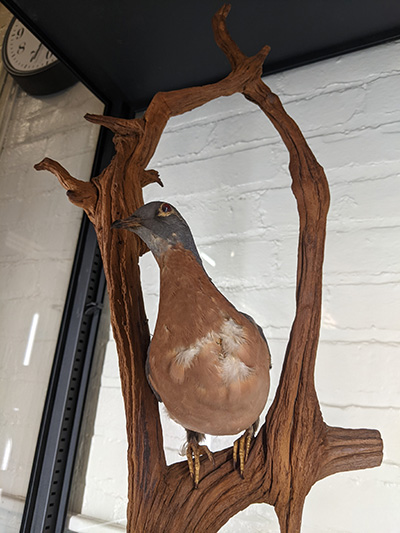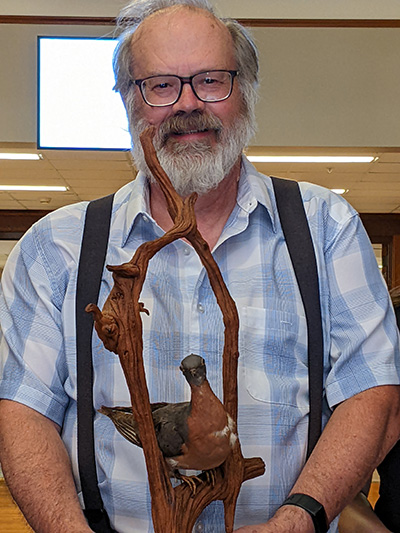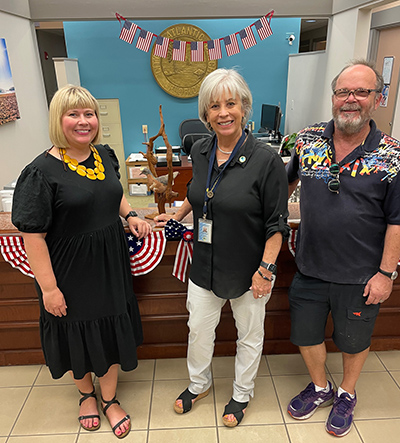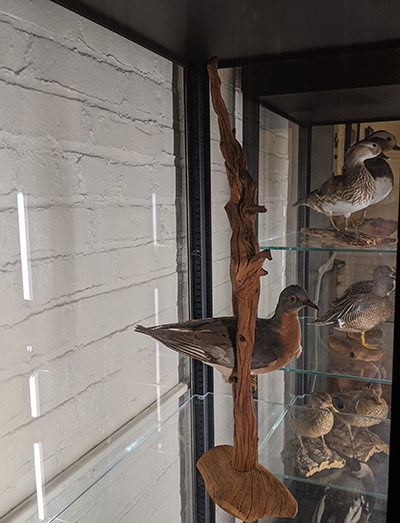Alumni Donation Brings Rare Passenger Pigeon to FNR Collection
 Passenger pigeons, or Ectopistes migratorius, were once believed to make up between 25 and 40 percent of the total bird population of the United States, according to the Smithsonian Institute. In the early 1800s, the bird was so numerous that when flocks flew past, people came out of their homes thinking that a solar eclipse was occurring, but the sun was actually dimmed by the sheer mass of pigeons flying overhead. By the early 1900s no wild passenger pigeons could be found. The last wild capture on record was in 1900. The last known living individual pigeon, named Martha in honor of Martha Washington, died at the Cincinnati Zoo in 1914 and is now on display at the Smithsonian Institute in Washington, D.C.
Passenger pigeons, or Ectopistes migratorius, were once believed to make up between 25 and 40 percent of the total bird population of the United States, according to the Smithsonian Institute. In the early 1800s, the bird was so numerous that when flocks flew past, people came out of their homes thinking that a solar eclipse was occurring, but the sun was actually dimmed by the sheer mass of pigeons flying overhead. By the early 1900s no wild passenger pigeons could be found. The last wild capture on record was in 1900. The last known living individual pigeon, named Martha in honor of Martha Washington, died at the Cincinnati Zoo in 1914 and is now on display at the Smithsonian Institute in Washington, D.C.
More than 100 years later, Andrew Howe saw a taxidermy mount of a passenger pigeon in a jewelry store in California, while in town attending the wedding of a high school friend. Howe, a 1980 alum of the School of Construction Management Technology at the Purdue Polytechnic Institute, purchased the mount and took it home to Florida.
In honor of the last known passenger pigeon, Martha, Howe named the pigeon George (aka George Washington).
“Kathy and I were born and raised in Cincinnati, so we were familiar with the fate of Martha, the last passenger pigeon," Howe explained. “When we saw George looking completely out of place on a California jewelry store counter, we rescued him and made shipping arrangements home between wedding events. We held our breath until FedEx delivered George to Atlantic Beach, Florida, without injury.”
Howe’s family has a deep history of birdwatching and ornithology. His grandmother Peg Chambers gave lectures on ornithology. His widowed mother Liz Chambers met her second husband/Howe’s adopted father Dr. A. Alan Chambers birdwatching and both of them had extensive bird life lists and traveled the world birdwatching. His mother, a nature stone sculptor of note in Cincinnati who lectured at the Cincinnati Nature Center, even sculpted a 60-pound granite falcon for Andrew’s office at a hotel development company after he graduated from Purdue.
After keeping the pigeon for a year, Howe decided to give George a new home to allow more people to take in the rare specimen. Eventually, he was contacted by Joel Greenberg, a Chicago author and birder who wrote “A Feathered River Across the Sky,” the definitive book on the passenger pigeon on the centennial of its extinction.
 Greenberg had met Purdue professor of wildlife ecology Dr. Barny Dunning several times birding along the Lakeshore and had spoken to Dunning’s Advanced Ornithology class in 2013. He also had gone birding at Willow Slough State Wildlife Management Area with students from the Purdue Department of Forestry and Natural Resources’ student chapter of The Wildlife Society several times over the years.
Greenberg had met Purdue professor of wildlife ecology Dr. Barny Dunning several times birding along the Lakeshore and had spoken to Dunning’s Advanced Ornithology class in 2013. He also had gone birding at Willow Slough State Wildlife Management Area with students from the Purdue Department of Forestry and Natural Resources’ student chapter of The Wildlife Society several times over the years.
Greenberg suggested that Howe donate the passenger pigeon to Purdue FNR, where he could be more widely admired by students, faculty, alumni and visitors alike. Howe agreed and the wheels were put in motion to relocate George to his new home.
“George's final flight to Purdue was serendipity from start to finish,” Howe said. “Immediately upon rescuing George I started finding and reading everything I could about passenger pigeon locations in the United States. I had read that passenger pigeon mounts are extremely rare, and most of the specimens were in museums or universities. Something that rare carries a ‘stewardship obligation’ and I determined that he needed to be shared with as many people as possible in a public setting. I submitted the information about George and his location to a website that lists every known specimen location. As we were deciding between the Cincinnati Natural History Museum and the Cincinnati Zoo Passenger Pigeon Pavilion as donation possibilities, I got a call from Joel asking if I would consider a donation to Purdue as there are only four passenger pigeons in the state of Indiana - one of them just a skeleton. I immediately said yes and several months later Kelly Delp escorted George on his last flight to West Lafayette. Upon landing on campus, George appropriately became a fellow Boiler.”
 Delp, Director of Development for the Purdue College of Agriculture, traveled to Atlantic Beach, Florida, to bring George to West Lafayette. But first, George had one more Florida adventure, stopping by to the see the mayor of Atlantic Beach, Ellen Glasser, at City Hall on June 7, 2022.
Delp, Director of Development for the Purdue College of Agriculture, traveled to Atlantic Beach, Florida, to bring George to West Lafayette. But first, George had one more Florida adventure, stopping by to the see the mayor of Atlantic Beach, Ellen Glasser, at City Hall on June 7, 2022.
After the plane ride back to Indiana as Delp’s delicate carryon, George was delivered to Purdue FNR by April Shepherd, Director of Development at the Purdue Research Foundation. Accepting on FNR’s behalf were Dunning, Laura Fehling and Rachel Brent. Dunning is the associate department head for academic programs and a professor of wildlife ecology. Fehling is the natural resources lab coordinator and FNR collections curator. Brent is the FNR specimen collection assistant.
“The extinction of the passenger pigeon is a well-known story about the early (mis-)management of natural resources in North America and we teach about the loss of this species in several FNR classes,” Dunning  said. “It has also been proposed to use modern genetic techniques to bring the species back, a process called “de-extinction.” Having a mount of this famous bird will help bring the pigeon back to life (so to speak) for our students as they learn about the protection of biological diversity.”
said. “It has also been proposed to use modern genetic techniques to bring the species back, a process called “de-extinction.” Having a mount of this famous bird will help bring the pigeon back to life (so to speak) for our students as they learn about the protection of biological diversity.”
George’s new home is a well-lit glass case in the FNR Collections Lab, where he will be seen by hundreds of students every year.
“The addition of the passenger pigeon to our collection will give students a rare opportunity to see an extinct species in person and to learn about their history,” Fehling said. “The story of the passenger pigeon's extinction can be a valuable instrument in teaching students about species conservation.”
FNR department head Dr. Bob Wagner agreed.
“Given the focus of our department on natural resources education, research, and extension, it is a tremendous honor to have such a rare and prominent symbol of wildlife conservation available for  everyone to see,” Wagner said. “We thank Mr. Howe for his very generous donation to our program.”
everyone to see,” Wagner said. “We thank Mr. Howe for his very generous donation to our program.”
Along with the taxidermy mount, Howe also donated an 1888 edition of The Birds of North America book by Jacob H. Studer, which features the passenger pigeon among its 119 artistic colored plates.






